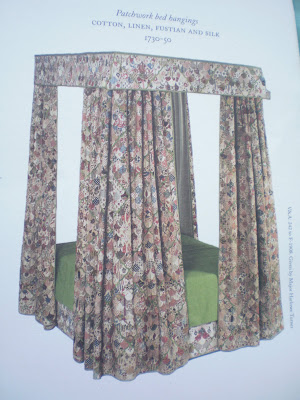
This four-poster bed with bizarre patchwork hangings graces the entrance to a fascinating exhibition at the V&A. Keep warm is almost irrelevant here; it's all about message: displaying wealth, supporting the empire and marking events in important families .
In five themed sections: The Domestic Landscape; Meeting the Past; Making a Living; Virtue and Virtuosity; Private Thoughts, Political Debates, the exhibition narrates a depressing but fascinating slice of social history
High-status families marked births and deaths with gifts of quilted pillows and the like, sometimes worked by the by governesses, more rarely by the lady of the house but most often bought in. They were objects of immense family value, passed down to generations. Commercially produced quilts from Canterbury and Exeter, centres of quilting excellence, also supplied the moneyed strata of society.
Commissioning hand-made domestic objects such as quilts meant exploitation of vulnerable workers, evidenced by archived female voices in Wales and Tyneside

The availablity of textiles in the nineteenth century meant women could showcase artistic and practical skills, virtues valued but restricted. They also signalled aspirations. A quote from George Eliot's The Mill on the Floss (1860) illustrates this, when Maggie Tulliver's father reminds her to 'Go on with your patchwork like a little lady'.
Quilts displayed patriotism in an age of political turmoil and jingoism, proked by fears of revolution, such as was happening in France.

Messages and images promoted sobriety, in the style of Victorian samplers. The Temperance Movement encourages patchwork as an alternative to alcohol. Quilts made by Wormwood Scrubs prisoners combined patches of stitched inspirational mottoes connecting crime with punishment and embroidered chains and bars and other prison paraphernalia.
Displays of quilts made by convicts or sailors on long sea-voyages are a reminder of the time-consuming and often communal nature of quilt-making.

For me, one of the most interesting specimens was an example of a printed quilt made in my home town of Preston, in a mill that once specialised in printed borders. It's now a garden centre. Although some would disagree, I think that's a sign of progress.
No comments:
Post a Comment